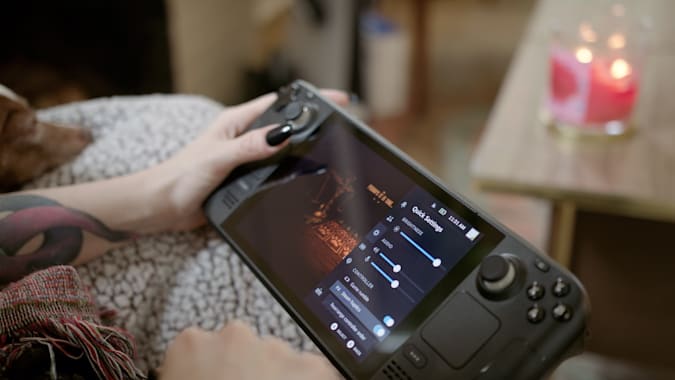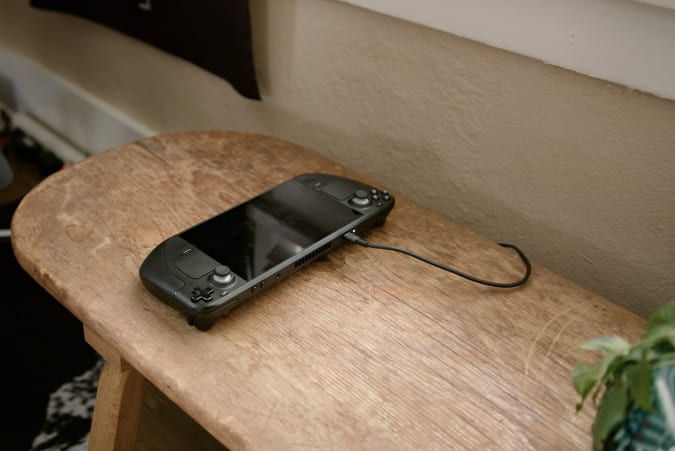This review is based on the mid-tier Steam Deck with 256GB of NVMe SSD storage, priced at $530. There’s also a 512GB model with a high-speed SSD and anti-glare etched glass that costs $650, and a 64GB version that’s just $400. Aside from offering a dismal amount of storage space, the 64GB model uses much slower eMMC storage, and I haven’t seen what that looks like in person.
All versions of the Steam Deck have the same AMD APU, which shares a lot of DNA with the chips inside the PS5 and Xbox Series consoles, along with 16GB of fast RAM, a 40Whr battery and a 7-inch 800p 60Hz display. SteamOS runs the whole damn thing and it takes up 30GB on my mid-tier model, leaving it with 227GB free — so keep that calculation in mind, too. There is a high-speed microSD slot so players can expand their libraries and even play games directly off a card, but internal storage is definitely faster than this method.
Now, the games. The Steam Deck is technically a handheld PC, which means it can theoretically support every game in Valve’s library, though this isn’t the case out of the box. Some Steam titles are officially optimized for the system, while some are not supported at all, and others are functioning on pure hope. There are four optimization levels — Verified, Playable, Unsupported and Untested — and so far, roughly 10 percent of my library falls in the Verified category. Valve rolled out a site where players can see how their games will fare on the Steam Deck, and across the board, the bulk of these titles are falling under the Untested category.
There is a workaround here, if you’re willing to put in the effort. The Steam Deck runs on a Linux-based operating system because that’s very much Valve’s thing, and this is the culprit behind the device’s compatibility issues. While some games run natively, the majority utilize Valve’s Proton compatibility layer to run Windows games. Proton has improved significantly over the years, but there are still a lot of issues, especially with online games that have aggressive anti-cheat solutions. If there’s a specific game you’re curious about, there are sites that collate user reports like ProtonDB which should give you an idea of how well something will run.
However, the Steam Deck is an open platform, and it’s possible to install Windows on the system and boot up Steam from there, with all the compatibility of a standard PC. This isn’t what the device was built to do, presenting a handful of UX concerns out of the gate, and more importantly, it’s not how the majority of owners are going to use the Steam Deck. For most players, it’ll be all about compatibility labels.
Engadget
I haven’t had a game-breaking issue with any Verified game on Steam Deck, and at worst, I’ve had to spend a few seconds adjusting framerate and brightness settings. In my experience, games labeled Playable generally perform well, though they often require a second glance at the control layout. Playing Inscryption, I was stuck on a scene for a few minutes before realizing I simply had to pull up the on-screen keyboard, which is accessible in the Quick Settings overlay at any time. A prompt appears before installing Playable games outlining their known issues on Steam Deck, like small font or mouse-and-keyboard icons, and it’s easy to make a decision about installing from there.
When it comes to untested games, you’re on your own. This is the Steam Deck’s wild west, and I’ve seen it all from titles in this category: Artful Escape won’t even load past the developer logo; BPM plays fine but it’s visually blown out; Kentucky Route Zero runs beautifully.
Figuring out how to unbreak a partially supported title on Steam Deck is a game in itself. My advice: If there’s a title you desperately want to play without interruption or frustration, then don’t play it on Steam Deck unless it’s Verified. You’ll likely just be annoyed and disappointed and probably a little sad.
This also might happen when trying to pair Bluetooth devices with the Steam Deck. This process has been hit-and-miss for me — my Xbox controllers refuse to connect to the Steam Deck (no, they weren’t paired with another device at the time) and my Samsung Galaxy Buds don’t even show up as available . However, my new Marshall Bluetooth speaker connects to the Steam Deck without fuss.
Engadget
The device’s USB-C port makes it possible to hook up a hub and connect a mouse, keyboard, display and ethernet cable, although I didn’t try this out. The official Dock, which is designed just for this use case, won’t come out until late spring and I’ll give it a whirl then.
I tested a handful of familiar games on Steam Deck, including Hades, Celeste, Devil May Cry 5, Inscryption, Cuphead and World of Horror, and I wouldn’t say that it felt better to play any title on the handheld, rather than PC . However, the Steam Deck delivers something worthwhile: flexibility.
The Steam Deck allows me to step away from my desktop, where I spend all day working, and play my games somewhere I can fully relax. Sure, this is already possible through Steam Link, but the Steam Deck makes the process more luxurious. I’ve loved having one in the house, and truly, it couldn’t have come at a better time. I just moved and I don’t have a TV yet, so I haven’t been able to escape to my living room after work as usual. The Steam Deck has filled the void left vacant by my PS5 and Xbox Series S, allowing me to play on the couch at the end of the day — at least until my neck gets sore.
Engadget
The Steam Deck’s battery life is less of an issue than I thought it would be, largely because the way I use the machine is different than I first imagined. Initially, I figured the Steam Deck would be more like a Switch Lite, something to throw in my bag and take out into the world, a truly mobile version of my Steam library. But in practice, I use the Steam Deck more like a Wii U — it stays at home and I play it on the couch after work or in bed at night, never far from its charger or a sensitive tabletop to rest it on.
The Steam Deck is a Frankenstein synthesis of a Wii U and a Vita, but with Valve’s DNA coursing through its cables. It’s a Steam Controller and a Steam Machine in one hefty package, and I’ve come to appreciate it for what it does best. The Steam Deck isn’t a mobile device to take on your everyday commute; it’s a Steam library extender, opening up new places to play around the house. I wouldn’t recommend the Steam Deck as an introduction to PC gaming, but for millions of existing Steam users, it’s worth the price of entry, even if you just play a few times a month, two hours at a time.
All products recommended by Engadget are selected by our editorial team, independent of our parent company. Some of our stories include affiliate links. If you buy something through one of these links, we may earn an affiliate commission.


